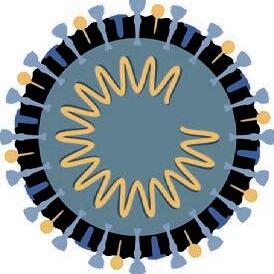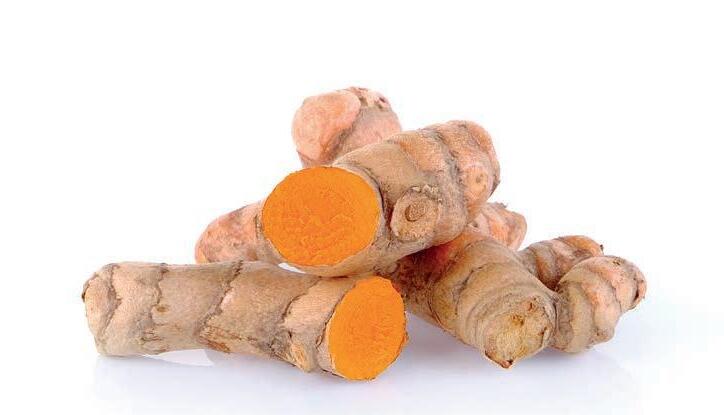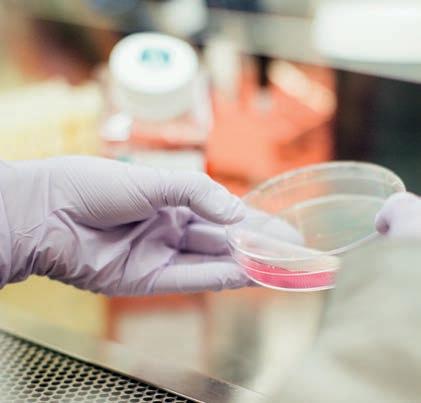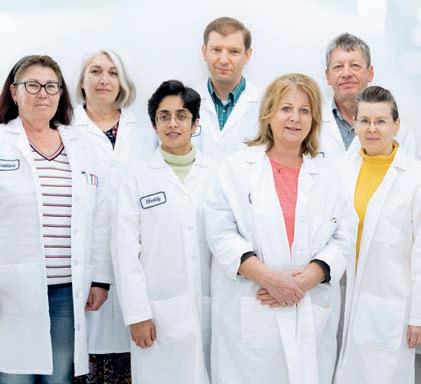VIRUSES
Stopping naturally
Scientifically developed micronutrient combinations as an effective strategy to naturally fight viral infections

Dr. Rath Health Foundation
Stopping viruses naturally
1st Edition
© 2023 Dr. Rath Health Foundation
Distribution: Dr. Rath Education Services B.V. Postbus 656, NL-6400 AR Heerlen
Tel.: 0031-457-111 222
Fax: 0031-457-111 119
Email: info@rath-eduserv.com
Internet: www.drrathbooks.com
All rights reserved. Published by Dr. Rath Health Foundation. Individual pages of this brochure may be used for private and nonprofit purposes only. Any direct or indirect commercial use of this brochure or extracts therefrom in any form without the written permission of the authors is strictly prohibited.
© Dr. Rath Health Foundation 3. Contents Introduction 5 Viruses – small but dangerous 6 How a viral infection develops 7 The crucial role of micronutrients in fighting viruses 8 The concept of nutrient synergy 12 An unbeatable combination: vitamin C and black tea extract 13 Synergy is key 13 An overview of potent virus killers 14 Extracts – concentrated plant power 20 Summary 21 Patented micronutrient combination to fight viral infections 22 References 23 Dr. Rath Research Institute 24 Researchers 25 Further information material 26

4.
Broccoli (Brassica oleracea var. italica)
Viruses are active throughout the year, causing infections in humans. There is usually a peak in infections during the autumn and winter months, notably for coronavirus infections and seasonal flu. While conventional medicine still relies on antiviral d rugs and vaccines, micronutrient-based approaches provide a unique opportunity to effectively prevent or manage viral infections.
T he human body is made up of billions of cells that need a constant supply of biocatalysts to perform vital biochemical reactions. In cellular medicine, these substances are called “cellular nutrients.” These include vitamins, minerals, trace elements, certain amino acids, biologically active phytonutrients, and other components needed for normal metabolism. T heir health benefits are well recognized, and there is growing evidence that certain micronutrients have an impressive ability to combat viral invaders.
Here we present unique research findings on how natural compounds, used in the right amounts and proportions, become valuable allies in the fight against infections, from human flu to COVID-19 and b eyond. They show that micronutrients combined in synergistic teams can simul -
taneously stop viruses from entering the c ells, inhibit their multiplication and at the same time boost our body’s immune response for enhanced protection.
These findings have important implications that go beyond our personal health benefits. By harnessing the power of micronutrients as a preventive measure or to complement traditional antiviral therapies, we c an establish the foundation for a safe and effective control of infections. At a time when viruses pose a significant challenge to global health, scientifically developed micronutrient-based approaches should be an integral part of public health strategies, especially during viral outbreaks, and should inspire future research in natural health.
© Dr. Rath Health Foundation 5.
Introduction
Viruses are tiny pathogens that cause infections. Unlike bacteria, which can generate their own energy and reproduce, viruses are not considered living organisms. They must invade the cells of a host and hijack its metabolism, in order to multiply and spread.
Viruses consist of genetic material – DNA or RNA – surrounded by an envelope. Specific proteins on the virus surface are used as anchors to attach to the host cell. These viral anchors use specific “docking sites” on the cell surface as entry points for viruses to enter the host cell. For example, coronaviruses use a surface protein called angiotensin-converting enzyme 2, or ACE2, to attach to and infect cells.
Particular viruses look different from one another, but they all invade and multiply in our body cells in a similar way, causing a variety of diseases. Well-known examples include the measles virus, the influenza virus, the herpes virus, the hepatitis B virus and the Ebola virus.The SARS virus, an acronym for “Severe Acute Respiratory Syndrome,” played a major role in the coronavirus pandemic.

6.
Viruses – small but dangerous
Once inside a host cell, such as a lung cell, viruses insert their own genetic material into the host DNA and reprogram the cell’s bi ological software to their own benefit. The infected cells then start replicating until they fill the entire cell, which bursts, spreading viruses into the surrounding tissue and in fecting more cells.
In addition to producing new viruses, all infected cells also increase the production of biological “scissors” that help to spread infections throughout the body. These are mainly collagen-digesting enzymes that can
Colored spikes on virus particles represent different proteins that each virus uses to attach to and infect cells.


“break up” the surrounding connective tissue to make way for the viruses, allowing


iruses multiply inside the cells until the cells explode, releasing more viruses to infect other cells.



© Dr. Rath Health Foundation 7.
FLU VIRUS
CORONA VIRUS
Genetic information (RNA)
Fig. 1: Diagram of viral structure: flu virus and coronavirus
How a viral infection develops
The crucial role of micronutrients in fighting viruses
Humans are particularly susceptible to viral infections because of our generally low vitamin intake and inability to produce key vitamins (e.g., vitamin C) internally, thus impairing the body’s defenses. This results in poor integrity of our “body barriers” such as the skin and mucous membranes, and impaired function of the immune system. Therefore, regular and optimal intake of vitamins and other micronutrients is the best protection against infection.
Our immune protection is based on a coordinated action of immune cells and organs. Micronutrients are essential for the production and activity of important defense cells, the white blood cells (leukocytes). These cells migrate through the body to the source of infection, where they ingest and kill pathogens and facilitate the removal of accumulated cellular waste. Micronutrients can also act directly on viruses by interfering with their multiplication inside our cells. Some micronutrients, such as vitamin C and the amino acid lysine, are particularly important. They can impair viral multiplication, support immune responses, and reduce the spread of infectious agents by preserving the integrity and strength of connective tissue as the inhibitors of collagen-digesting enzymes, and by increasing collagen production.
Example 1: Influenza viruses
Influenza is one of the oldest and most common infectious diseases, affecting 3 to 5 million people each year. Influenza can be life threatening, especially for young children, the elderly and people with a weakened immune system.
There are four types of influenza viruses: A, B, C and D. Seasonal flu epidemics are caused by influenza A and B viruses. In recent years, there have been outbreaks of avian influenza (influenza A virus H5N1) and swine flu (influenza A virus H1N1) that have claimed many lives.
Scientists at the Dr. Rath Research Institute studied the effects of certain micronutrients on the growth and spread of different types of influenza viruses, including human flu virus H1N1. Important implications of this research include:
• Natural prevention of the spread of flu viruses based on the effectiveness of micronutrients in inhibiting an enzyme on the surface of viral particles (neuraminidase) that viruses use to escape from host cells and infect other cells.
8.
• Natural decrease of virus multiplication based on the efficacy of micronutrients in stopping the replication of H1N1 influenza A virus in infected kidney cells.
• The hindering of viral spread in tissues, based on micronutrient efficacy in inhibiting production of collagen-digesting enzymes in cells infected with the human influenza A virus H1N1.
Further scientific results from the Dr. Rath Research Institute also show that a specific combination of micronutrients is much more effective against the avian flu virus than Tamiflu® and other antiviral drugs.
© Dr. Rath Health Foundation 9.
Increasing concentrations of micronutrients Influenza antigen (units/ml) 450 0 400 350 300 250 200 150 100 50 -50 Control
Fig. 3: Multiplication of influenza A virus stopped by micronutrients
Example 2: Coronaviruses
Despite numerous and drastic public health measures, the SARS-CoV-2 coronavirus has claimed millions of lives worldwide. Unfortunately, in all the efforts to control the COVID-19 pandemic, public recommendations have often ignored the most important and effective measure: boosting the immune system with micronutrients. However, scientific studies have been increasingly supporting the application of micronutrient-based approaches as a new therapeutic strategy to combat the COVID-19 pandemic.
In the search for a comprehensive control of SARS-CoV-2 and its mutated forms, a group of scientists from the Dr. Rath Research Insti-
Micronutrient combinations affect all key cellular processes associated with coronavirus infections.
tute turned to micronutrients. The studies led to the development of a specific synergy of micronutrients capable of inhibiting multiple steps of the SARS-CoV-2 virus and its mutants. The results showed that micronutrients:
1. Inhibit coronavirus binding to human lung and blood vessel cells.
2. Inhibit the entry of SARS-CoV-2 coronavirus and its various mutated forms into human cells.

3. Inhibit key enzymes required by the coronavirus to replicate in human cells.
4. Inhibit the multiplication of coronaviruses in the lungs and reduce inflammation.
10.
ACE2
Furine Catepsin L
" "
Viral RNA Nucleus
Fig. 4: The illustrations and experimental results shown here are all part of the patented technology granted to help fight coronaviruses in a natural way.
Since all coronavirus variants and mutants use common mechanisms and enzymes to infect and replicate in human cells, this implies that micronutrients may also be effective in preventing future infections with newly emerging, as yet unknown, coronavirus variants.
Fig. 5: Micronutrients inhibit the cellular entry of the SARS-CoV-2 virus and its various mutants. More than 40% inhibition was observed for the original SARS-CoV-2 virus and its Delta, Beta and Omicron variants.

11.
© Dr. Rath Health Foundation
0 20 40 60 80 100 120 Control 10 µg/ml Mix Micronutrients
Micronutrients Control Viral cellular entry (% of control)
The concept of nutrient synergy
The concept of nutrient synergy, which is systematically applied in our research, is gaining increasing interest. Nutrient synergy is defined as the interaction between different nutrients when consumed together, resulting in enhanced health benefits that may not be achieved when these nutrients are consumed individually. In practical terms, this means that, in order to achieve specific health benefits, it is important to look for scientifically developed nutrient compositions with proven efficacy, rather than relying on single compounds or random combinations of nutrients.
These research-based, synergistic approaches have been recognized by various US and international patents for controlling viral infections and boosting immunity.
Individual micronutrients are very powerful on their own. But when they work together, they expand their full power and provide maximal benefits. An example of how the effectiveness of a single nutrient – vitamin C – in inhibiting bird flu virus multiplication can be enhanced by its combination with other natural compounds is presented in Fig. 6.
12.
Fig. 6: Micronutrients synergy enhances inhibitory effect of vitamin C on the multiplication of human flu virus.
Viral multiplication marker % of control Vitamin C 20% decrease Nutrient synergy 71% decrease Control 100 250 500 1000 2000 3000 120 100 80 60 40 20 0 Increasing concentrations of nutrient synergy and vitamin C
An unbeatable combination: vitamin C and black tea extract
Did your grandmother recommend black tea with lemon to treat colds? Research conducted by the Dr. Rath Research Institute proves that certain traditional remedies do indeed have a scientific basis. The studies focused on the effects of vitamin C together with theaflavin, an ingredient in black tea, and other natural compounds. When used together, these micronutrients can block specific entry points (ACE2 receptors) used by

Synergy is key
Valuable additions to these natural compounds include turmeric, cruciferous vegetables (cabbage), naringin, resveratrol, and quercetin, the antiviral activity of which has been extensively tested in further experiments by the Dr. Rath Research Institute.
SARS-CoV-2 on human cells, which makes it impossible for the virus to pass through. In the studies, vitamin C alone had a significant and consistent effect on decreasing ACE2 expression; the combination with theaflavin and baicalin, the extract from Baikal hellebore, produced particularly good results. Together, these cellular nutrients are highly effective in inhibiting the cellular entry points for the coronavirus. See Fig. 7 and 8 on pages 16-17.
The combined micronutrients work synergistically – only the interaction fully inhibits the invasion and replication of the SARS-CoV-2 virus. The replication capacity in the cells is significantly reduced.
© Dr. Rath Health Foundation 13.
An overview of potent virus killers
• Vitamin C increases the activity of immune cells. It is also necessary for the repair and regeneration of collagen, an important component of the body‘s natural barriers, such as skin, mucus membranes, and others. Its proven health benefits include direct interruption of the life cycle of viruses and other pathogens. Vitamin C also supports the efficacy of other vitamins, regenerating them and helping phytochemicals to enhance their effects.

Vitamin C has shown beneficial effects in COVID-19 both at the early and advanced stages of infection. High vitamin C doses applied intravenously resulted in significant clinical improvement in COVID-19 patients, particularly in curbing excessive inflammation, termed a “cytokine storm.” This vitamin works at i several metabolic levels, including regulating gene expression.
In addition, vitamin C can enhance the effect of other natural components, creating synergy that boosts their efficacy.
14.
Broccoli (Brassica oleracea var. italica)
• The cruciferous family, which includes cabbage, cress, radish, white mustard, black mustard, and rapeseed, is an important contributor to good health with its high levels of organic plant components.
The so-called “glucosinolates” deserve special attention. These are phytochemicals with pungent sulfur compounds. They give cabbage its bitter taste and mustard and horseradish their pungency.
Sulforaphane is a biologically active phytochemical found in high concentrations in broccoli. Cruciferous plants protect themselves against disease through these sulfur-containing compounds. Several studies suggest that sulforaphane may help to prevent various t ypes of infection.
• Quercetin is a natural plant sub stance from the flavonoid group, belonging to polyphenols. It is found as a yellow pigment in dyer’s oak, but also in apples, onions, grape skins, and wine. Quercetin is used as a building block for other flavonoids.

The effects of quercetin are many and varied. For example, as an antioxidant, it can protect cells and organs from oxidative stress. It helps to prevent viral replication by killing viruses inside the cells. Quercetin can also protect infected cells from damage by pathogens and support the repair process of cells.
Grapefruit contains naringin, a polyphenol with mainly antioxidant properties.

• Naringin is a flavonoid found mainly in grapefruits and pomelos, giving them their bitter taste. Naringin has many positive effects in the body, including the ability to fight viruses, bacteria and fungi.

© Dr. Rath Health Foundation 15.
Grapefruit (Citrus × paradisi)
Red grapes (Vitis vinifera subsp. vinifera)
• Theaflavins are mainly formed during the fermentation of green tea into black tea from the catechins it contains and during their metabolism in the liver. They are nat-

ural anti-inflammatories, stimulate immune system cells (killer cells) and have been shown to prevent the binding of SARSCoV-2 spikes to ACE2 cellular receptors.
Effect of vitamin C and theaflavin on expression of ACE2 receptors
without vitamin C with 800 µ M of vitamin C
Fig. 7: Concentration-dependent inhibition of coronavirus entry points (ACE2 receptors) in human lung cells by theaflavin (light green bars) and theaflavin in combination with 800 μM vitamin C (green bars). At a concentration of 33 μg/ml theaflavin, ACE2 receptors were reduced by about 50%, and in combination with vitamin C (ascorbic acid) by as much as 87%.
16.
Theaflavin, µg/ml ACE2 expression, % of control 120 0
Black Tea
0 11 33 100 80 60 40 20
Effect of vitamin C and baicalin on the formation of ACE2 receptors
without vitamin C with 800 µ M of vitamin C
also been shown to be effective against other coronaviruses. The plant has a broad spectrum of antiviral activity. 100 80 60 40 20 100
Baicalin, µg/ml

Health Foundation 17.
© Dr. Rath
Baicalin
• Baicalin, derived from an extract of the Baikal hellebore, is a medicinal plant used in traditional Chinese medicine. Scutellaria baicalensis, as it is known in Latin, has 120 0 0 25 50
ACE2 expression, % of control
Fig. 8: Baicalin, together with vitamin C, helps to inhibit the viral entry points (ACE2 receptors), preventing the coronavirus from entering the body. In the Dr Rath Research Institute study, this combination inhibited the receptors by up to 82%.
• Curcumin is a flavonoid found in the spice plant Curcuma longa (turmeric), the “Indian spice”, used primarily as an important component of classic curry. But turmeric is not only popular in Indian cuisine.

The antioxidant and anti-inflammatory properties of the curcumin found in turmeric are well documented, confirming its therapeutic use against various diseases. Curcumin is also a very potent antiviral agent, able to inactivate viruses at various stages of infection.
To reap the health benefits of curcumin, it is not enough to sprinkle turmeric powder over your food. This is because ground turmeric root contains very little curcumin. Curcumin is also difficult to absorb in the body. The solution is to take a high-quality supplement that contains the plant’s active ingredient in optimal dosage and bioavailability.
Curcumin is the active ingredient in turmeric that has a positive influence on our body.
• N -acetyl-cystein is the starting substance to synthesize the body’s own glutathione, a powerful antioxidant that protects our cells from oxidative damage and is important for healthy function of our immune system. The main role of glutathione is to eliminate radical oxygen molecules and remove toxic substances from cellular metabolism.
The stable form of the non-essential amino acid L-cysteine, N-acetyl-cysteine, supports the other active ingredients of the cellular nutrient synergy developed at the Dr. Rath Research Institute.
18.
Turmeric (Curcuma longa)
• Resveratrol is a polyphenol that works as a component of the plant’s own immune system. It protects plants against bacteria, fungi and viruses, pests and harmful environmental influences such as toxins, UV radiation and ozone pollution. Japanese knotweed (Fallopia japonica), which contains resveratrol in all its parts, is a rich source of resveratrol. This plant has been used for centuries in its native Japan to make medicinal teas.
Resveratrol is a potent antioxidant. It is also highly valued in naturopathy for its antiviral properties: it is effective in reducing viral proliferation and replication and the inflammation that results from viral infections. The antiviral activity of resveratrol has also been demonstrated against viruses such as influenza A and B, SARSCoV-2 and rhinovirus.

© Dr. Rath Health Foundation 19.
Japanese knotweed (Fallopia japonica)
Extracts – concentrated plant power
In food technology and pharmacy, an extract is the concentrated essence of a single raw material acquired by an extraction process using a solvent (water, oil or alcohol). The process removes undesirable constituents and concentrates desirable substances that determine efficacy. Fresh or dried plants (or parts of plants) are mainly used to produce extracts. The advantage of using plant extracts is that the active ingredient content is precisely defined and controlled. An extract, no matter where it comes from, always contains a certain amount of ingredients with known therapeutic efficacy. Extracts also

allow the perishable fresh plant parts to be preserved and presented in a highly concentrated form. There is a huge difference between eating an apple every day and taking valuable, scientifically tested plant extracts.
For illustration: To get 50 mg of resveratrol, we need to drink 45 liters of grape juice or 3.5 liters of red wine; 400 mg of sulforaphane is found in 3 kg of radish, and the same amount of quercetin is found in 10 kg of green beans or 11 kg of apples. The extract is therefore a valuable addition to our diet.
20.
Summary
The use of specific micronutrients is an effective natural approach to fighting the SARS-CoV-2 virus and its mutations, as well as many other viruses. A finely tuned and scientifically tested combination of micronutrients can affect multiple aspects of infection at once, such as supporting the immune system, boosting the body‘s resistance and specifically attacking infectious pathogens. While a well-balanced, vitamin-rich diet is
the basis for strengthening the body‘s defenses, supplementation with specific cellular nutrients can further enhance our body’s immune system in mounting a strong resistance to infections.

© Dr. Rath Health Foundation 21.
Patented micronutrient combination to fight viral infections
The combination of vitamin C, N-acetylcysteine, theaflavin, resveratrol, cruciferous plant extract, curcumin, quercetin, naringin, and baicalin developed by the Dr. Rath Research Institute can simultaneously control key infectivity mechanisms of the SARSCoV-2 coronavirus and its mutants. This special combination, which was proven to be more effective than each compound used alone, received US patents (Patent No.: US 2021/0315857 A1; US 11,419,847 B2), making it unique in the world.

For further information go to: www.dr-rath-education.org
US Patent No. US11419847

Pharmaceutical micronutrient composition and its use to simultaniously inhibit multiple cellular mechanisms of infectivity caused by coronavirus, its variants and mutants
Inventors: Aleksandra Niedzwiecki, Matthias Rath, Vadim Ivanov, Anna Goc
Publishing date: August 23, 2022
22.
Researcher Dr. Anna Goc examines a petri dish.
A. Goc, A. Niedzwiecki, V. Ivanov, S. Ivanova, M. Rath. Inhibitory effects of specific combination of natural compounds against SARS-CoV-2 and its Alpha, Beta, Gamma, Delta, Kappa, and Mu variants. Eur J Microbiol Immunol (Bp). 2022 Jan 21.
https://akjournals.com/view/journals/1886/ aop/article-10.1556-1886.2021.00022/ article-10.1556-1886.2021.00022.xml
V. Ivanov, A. Goc, S. Ivanova, A. Niedzwiecki, M. Rath. Inhibition of ACE2 Expression by Ascorbic Acid Alone and its Combinations with Other Natural Compounds. Infect Dis (Auckl). 2021 Feb 14;14:1178633721994605.
https://www.dr-rath-foundation.org/ wp-content/uploads/2021/02/PublishedACE2-Vit-C-others-21621.pdf
Dr. Rath Health Foundation (2021). Ein natürlicher Ansatz zur umfassenden Bekämpfung von SARS-CoV-2.
https://www.dr-rath-foundation.org/ 2021/10/ein-natuerlicher-ansatz-zurumfassenden-bekaempfung-von-sarscov-2/?lang=de
M. W. Roomi, R. J. Jariwalla, T. Kalinovsky, N. Roomi, A. Niedzwiecki, M. Rath. Biofactors. 2008;33(1):61-75.
P. Deryabin, D. Lvov, A. Botikov, V. Ivanov, T. Kalinovsky, A. Niedzwiecki, M. Rath. Effects of a nutrient mixture on infectious properties of the highly pathogenic strain of avian influenza virus A/H5N1. Biofactors. 2008;33(2):85-97.
R. J. Jariwalla, M. W. Roomi, B. Gangapurkar, T. Kalinovsky, A. Niedzwiecki, M. Rath. Suppression of influenza A virus nuclear antigen production and neuraminidase activity by a nutrient mixture containing ascorbic acid, green tea extract and amino acids. Biofactors. 2007;31(1):1-15.
© Dr. Rath Health Foundation 23.
References
DR. RATH RESEARCH INSTITUTE
The Dr. Rath Research Institute, based in California, USA, brings together leading scientists in medicine, biochemistry, and nutrition. Led by Dr. Aleksandra Niedzwiecki, this research team has been advancing our knowledge in natural health by exploring micronutrient synergies and developing innovative health approaches to effectively prevent and treat a wide range of diseases. This research is based on Dr. Rath‘s pioneering discoveries in cardiovascular disease, cancer, and other important health areas, and its findings are regularly published in scientific journals around the world.


www.drrathresearch.org

24.
RESEARCHERS
Currently the Director of Research at the Dr. Rath Research Institute, Dr. Niedzwiecki is a leading biomedical researcher in the development of nutrient synergy approaches in various aspects of health and disease. Her work in the areas of cardiovascular health, cancer and infections has won her recognition for her research into the biochemical link between disease and nutrients.


Dr. Goc is head of the Microbiology Laboratory, where she works on the development of effective and safe approaches to the control of infectious diseases. She has wide-ranging knowledge in the fields of microbiology, immunology, cancer, and vascular biology. Her research work has been published in numerous scientific journals and has been recognized by national and international awards and patents.
Dr. Ivanov holds a medical degree from the Tomsk Medical Academy in Tomsk, Russia, and doctorate degree in biochemistry from the National Cardiology Center in Moscow, Russia. He and his team at the Dr. Rath Research Institute have been conducting scientific studies on the benefits of micronutrients in important aspects of health, such as cardiovascular disease, infectious diseases and various metabolic disorders. The results of these studies have been featured in numerous publications and have been granted national and international patents.
Dr. Rath is a world-renowned physician and scientist known for his pioneering research in natural and cellular health. He is the founder of the scientific concept of Cellular Medicine – the systematic introduction into clinical medicine of the bio- chemical knowledge of the role of micronutrients as biocatalysts in a multitude of metabolic reactions at the cellular level.


Disclaimer:
This booklet is not intended as a substitute for the medical advice of a physician. The reader should regularly consult a physician in matters relating to his or her health and particularly in respect to any symptoms that may require diagnosis or medical attention.
© Dr. Rath Health Foundation 25.
Dr. Aleksandra Niedzwiecki
Dr. Anna Goc
Dr. Vadim Ivanov
Dr. Matthias Rath
Further information material

Please feel free to order further brochures from this series by telephone: 0031-457-111 222 or by email: info@dr-rath-foundation.org All publications are also available online at: www.issuu.com/drrath
CELLULAR HEALTH AND COVID-19 - Questions and Answers

This booklet answers key questions about COVID-19, current vaccines, and how implementing a science-based natural approach can help to control the COVID-19 pandemic.

LYME DISEASE

In Europe, well over 65,000 cases of Lyme disease are officially registered each year. However, the actual number of Lyme disease cases is possibly many times higher. This is because Lyme disease shows a variety of symptoms that are difficult to classify. They are described in detail in this brochure and natural health approaches are explained.
FIBRES FIBRES
Although dietary fibre is indigestible for the human body, it has a positive influence on health. By directly and indirectly influencing various metabolic processes, fibre can protect against the development of certain diseases or contribute to their treatment. Consequently, dietary fibre should always be taken into account as a component of a health-promoting, wholesome and balanced diet.

PROBIOTICS
PROBIOTICS
This brochure shows the enormous importance of the gut microbiota and its influence on numerous processes in the organism. Without bacteria, humans would not be able to withstand the various influences from the environment, diet, pathogens, medications, etc.
26.
Dr. Rath Health Foundation CELLULAR HEALTH and COVID-19 Questions and Answers Dr. Aleksandra Niedzwiecki PhD, Dr. Matthias Rath, MD
Dr. Rath Health Foundation
Dr. Rath Health Foundation LYME DISEASE Anna Goc, Ph.D. Aleksandra Niedzwiecki, Ph.D. Matthias Rath, M.D.
Dr. Rath Health Foundation
Art. Nr. 6????? A rt. Nr. 6????? A rt. Nr. 6????? A rt.
6?????
Nr.
© Dr. Rath Health Foundation 27.
Dr. Rath Health Foundation
Tesla 1 6422 RG Heerlen
The Netherlands
Tel.: 0031-457-111 222
Fax: 0031-457-111 119

E-Mail: info@dr-rath-foundation.org
Read
#1714/01-180823-EN
Internet: www.dr-rath-foundation.org us on Issuu






































